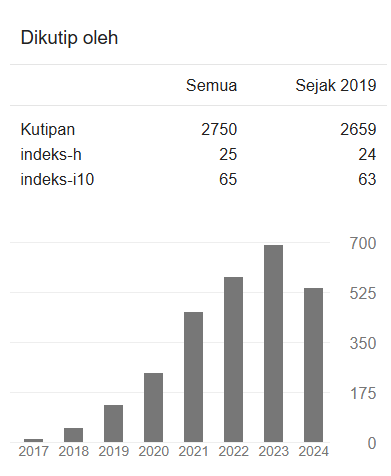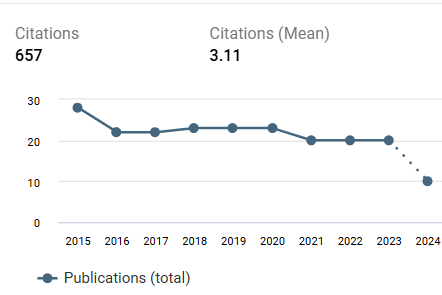Pengembangan bahan ajar open-ended melalui polysynchronous learning berbantuan canvas
DOI:
https://doi.org/10.22219/jinop.v7i2.15043Keywords:
Canvas, Teaching Materials, Open-Ended, Polysynchronous LearningAbstract
The current Covid-19 pandemic has severely impacted education where learning must be carried out online. Canvas is among polysynchronous e-learning platforms available. This study aims to describe the effectiveness of open-ended teaching materials through Canvas-assisted Polysynchronous Learning. This topic was chosen considering the importance teaching materials to support the implementation of Polysynchronous Learning. This study developed learning modules and power points as learning media, and Google form as evaluation media. Research and Development (R&D) approach was employed with ADDIE (Analysis, Design, Development, Implementation, and Evaluation) development model. These materials were validated by material and media experts to measure their effectiveness. Results show that the teaching materials are valid and feasible. These teaching materials were implemented through a polysynchronous learning where student activities reached 89%. It is implied that these materials could enhance student learning. Students’ learning outcomes (final test) are categorized good with the average score of 80.8; the distribution of 44 points for A, 24 for B+, and 12 for B.
Downloads
References
Andrianto, R., Sulaiman, M. M., & Yulianto, M. A. (2020). Aplikasi interaktif teknolog layanan jaringan sebagai media belajar siswa berbasis android. Journal of Multi-Disciplinary Sciences, 1(01), 34–43.
Anggoro, B. S. (2015). Pengembangan modul matematika dengan strategi problem solving untuk mengukur tingkat kemampuan berpikir kreatif matematis siswa. Al-Jabar: Jurnal Pendidikan Matematika, 6(2), 122–129. https://doi.org/10.24042/ajpm.v6i2.25
Ariani, I. M. D., Candiasa, I. M., & Marhaeni, A. (2014). Pengaruh Implementasi Open-Ended Problem Dalam Pembelajaran Matematika Terhadap Kemampuan Pemecahan Masalah Dengan Pengendalian Kemampuan Penalaran Abstrak. Jurnal Ilmiah Pendidikan Dan Pembelajaran Ganesha, 4(1), 207532. https://doi.org/10.23887/jpepi.v4i1.1167
Arsanti, M. (2018). Pengembangan bahan ajar mata kuliah penulisan kreatif bermuatan nilai-nilai pendidikan karakter religius bagi mahasiswa prodi pbsi, fkip, unissul. KREDO : Jurnal Ilmiah Bahasa Dan Sastra, 1(2), 72–90. https://doi.org/10.24176/kredo.v1i2.2107
Bahar, A., & June Maker, C. (2015). Cognitive backgrounds of problem solving: A comparison of open-ended vs. closed mathematics problems. Eurasia Journal of Mathematics, Science and Technology Education, 11(6), 1531–1546. https://doi.org/10.12973/eurasia.2015.1410a
Baldwin, S. J., & Ching, Y.-H. (2019). Online Course Design: A Review of the Canvas Course Evaluation Checklist. The International Review of Research in Open and Distributed Learning, 20(3). https://doi.org/10.19173/irrodl.v20i3.4283
Budd, S. (2020). Science literacy in a changing World: Covid-19 and CitySprouts Youth. CitySprouts.
Damayanti, H. T., & Sumardi. (2018). Mathematical Creative Thinking Ability of Junior High School Students in Solving Open-Ended Problem. JRAMathEdu (Journal of Research and Advances in Mathematics Education), 3(1), 36. https://doi.org/10.23917/jramathedu.v3i1.5869
Darmawan, D. (2012). Teknologi Pembelajaran. PT. Remaja Rosdakarya.
Drennan, G., & Moll, I. (2018). A conceptual understanding of how educational technology coaches help teachers integrate iPad affordances into their teaching. Electronic Journal of E-Learning, 16(2).
Edutechnica. (2019). LMS data-Spring 2019 updates.
Farwati, R., Permanasari, A., Firman, H., & Suhery, T. (2018). Integrasi Problem Based Learning dalam STEM education berorientasi pada aktualisasi literasi lingkungan dan kreativitas. Seminar Nasional Pendidikan IPA, 1(1), 198–206.
Fathurrohman, M. (2015). Model – Model Pembelajaran Inovatif (Alteratif Desain Pembelajaran yang Menyenangkan). Ar-Ruzz Media.
Fauzi, A., Husamah, H., Miharja, F. J., Fatmawati, D., Permana, T. I., & Hudha, A. M. (2020). Exploring COVID-19 Literacy Level among Biology Teacher Candidates. EURASIA Journal of Mathematics, Science and Technology Education, 16(7).
Fergiyanti, M., & Masjudin. (2016). Pengaruh problem based learning (PBL) terhadap aktivitas dan hasil belajar segiempat pada siswa kelas VII SMPN. Jurnal Media Pendidikan Matematika, 4(1), 14–19. https://doi.org/10.33394/mpm.v4i1.119
Gokce, S., Yenmez, A. A., & Ozpinar, I. (2017). An Analysis of Mathematics Education Students’ Skills in the Process of Programming and Their Practices of Integrating It into Their Teaching. International Education Studies, 10(8), 60. https://doi.org/10.5539/ies.v10n8p60
Handarini, O. I., & Wulandari, S. S. (2020). PembelajarHandarini, O. I., & Wulandari, S. S. (2020). Pembelajaran Daring Sebagai Upaya Study From Home (SFH). Jurnal Pendidikan Administrasi Perkantoran (JPAP), 8(3), 465–503.an. Jurnal Pendidikan Administrasi Perkantoran (JPAP), 8(3), 465–503.
Hartono. (2014). Statregi Pemecahan Masalah. Graha Ilmu.
Huda, S., Rinaldi, A., Suherman, S., Sugiharta, I., Astuti, D. W., Fatimah, O., & Prasetiyo, A. E. (2019). Understanding of mathematical concepts in the linear equation with two variables: Impact of e-learning and blended learning using google classroom. Al-Jabar: Jurnal Pendidikan Matematika, 10(2), 261–270. https://doi.org/10.24042/ajpm.v10i2.5303
Kurniawan, A. D. (2013). Metode inkuiri terbimbing dalam pembuatan media pembelajaran biologi untuk meningkatkan pemahaman konsep dan kreativitas siswa SMP. Jurnal Pendidikan IPA Indonesia, 2(1), 8–11. https://doi.org/10.15294/jpii.v2i1.2503
Kusumaningrum, R., Budiyono, B., & Subanti, S. (2015). Eksperimentasi model pembelajaran kooperatif tipe two stay two stray (TSTS), numbered heads together (NHT), dan think pair share (TPS) pada materi lingkaran ditinjau dari kreativitas belajar matematika siswa SMP Negeri di Kabupaten Sukoharjo. Jurnal Pembelajaran Matematika, 3(7). https://www.neliti.com/id/publications/122847/eksperimentasi-model-pembelajaran-kooperatif-tipe-two-stay-two-stray-tsts-number
Munkhtsetseg, N., & Uyanga, S. (2013). Implementation of E-Learning System : Findings and Lessons Learned. 2013(January), 18–24.
Ouyang, F. (2016). Applying the polysynchronous learning to foster the student-centered learning in the higher education context: A blended course design. In Blended Learning: Concepts, Methodologies, Tools, and Applications (Vol. 4). https://doi.org/10.4018/978-1-5225-0783-3.ch019
Prastowo, A. (2011). Panduan kreatif membuat bahan ajar inovatif. Yogyakarta: DIVA press.
Sholihah, D. A., & Mahmudi, A. (2015). Keefektifan experiential learning pembelajaran matematika mts materi bangun ruang sisi datar. Jurnal Riset Pendidikan Matematika, 2(2), 175. https://doi.org/10.21831/jrpm.v2i2.7332
Sinclair, J., & Aho, A.-M. (2018). Experts on super innovators: understanding staff adoption of learning management systems. Higher Education Research & Development, 37(1), 158–172. https://doi.org/10.1080/07294360.2017.1342609
Solso. (2008). Psikologi Kognitif Edisi Delapan. Erlangga.
Sulistyowati, Y., & Sugiman. (2014). Pengembangan Perangkat Pembelajaran Bangun Ruang di SMP dengan Pendekatan Creative Problem Solving. Pythagoras: Jurnal Pendidikan Matematika, 9(2), 219–232. https://doi.org/10.21831/pg.v9i2.9082
Swart, A. J. (2015). Student usage of a learning management system at an open distance learning institute: A case study in electrical engineering. International Journal of Electrical Engineering Education, 52(2), 142–154. https://doi.org/10.1177/0020720915575925
Wulandari, B., & Surjono, H. D. (2013). Pengaruh problem-based learning terhadap hasil belajar ditinjau dari motivasi belajar PLC di SMK. Jurnal Pendidikan Vokasi, 3(2). https://doi.org/10.21831/jpv.v3i2.1600
Yaumi, M. (2018). Media dan Teknologi Pembelajaran. In Jakarta.
Downloads
Published
How to Cite
Issue
Section
License
Copyright (c) 2021 Susanti et al

This work is licensed under a Creative Commons Attribution 4.0 International License.
Copyright Notice
Authors who publish with JINoP (Jurnal Inoasi Pembelajaran) agree to the following terms:
- For all articles published in the JINoP (Jurnal Inovasi Pembelajaran), copyright is retained by the authors. Authors give permission to the publisher to announce the work with conditions. When the manuscript is accepted for publication, the authors agree to the automatic transfer of the publishing right to the publisher.
- Authors retain copyright and grant the journal the right of first publication with the work simultaneously licensed under a Creative Commons Attribution 4.0 International License. that allows others to share the work with an acknowledgment of the work's authorship and initial publication in this journal.
- Authors are able to enter into separate, additional contractual arrangements for the non-exclusive distribution of the journal's published version of the work (e.g., post it to an institutional repository or publish it in a book), with an acknowledgment of its initial publication in this journal.
- Authors are permitted and encouraged to post their work online (e.g., in institutional repositories or on their website) prior to and during the submission process, as it can lead to productive exchanges, as well as earlier and greater citation of published work (See The Effect of Open Access).








